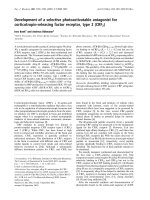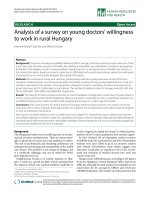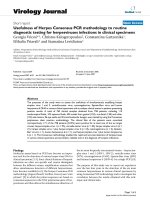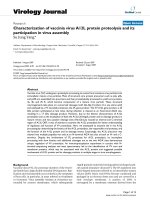báo cáo sinh học:" Development of a quality assurance handbook to improve educational courses in Africa" docx
Bạn đang xem bản rút gọn của tài liệu. Xem và tải ngay bản đầy đủ của tài liệu tại đây (216.09 KB, 5 trang )
BioMed Central
Page 1 of 5
(page number not for citation purposes)
Human Resources for Health
Open Access
Research
Development of a quality assurance handbook to improve
educational courses in Africa
Helen M Nabwera*
1
, Sue Purnell
2
and Imelda Bates
1
Address:
1
Liverpool School of Tropical Medicine, University of Liverpool, Liverpool, UK and
2
Educational Development Division, Centre for
Lifelong Learning, University of Liverpool, Liverpool, UK
Email: Helen M Nabwera* - ; Sue Purnell - ; Imelda Bates -
* Corresponding author
Abstract
Background: The attainment of the Millennium Development Goals has been hampered by the lack of
skilled and well-informed health care workers in many developing countries. The departure of health care
workers from developing countries is one of the most important causes. One of the motivations for
leaving is that developed countries have well-established health care systems that incorporate continuing
medical education, which enables health care workers to develop their skills and knowledge base. This
provision is lacking in many developing countries. The provision of higher-education programmes of good
quality within developing countries therefore, contributes to building capacity of the health care workforce
in these countries.
Methods: The Liverpool School of Tropical Medicine is involved in delivering off-site higher educational
programmes to health care workers in Africa. Our colleagues at one of these sites requested a guide to
help them ensure that their professional development courses met international educational standards.
We reviewed published literature that outlines the principles of quality assurance in higher education from
various institutions worldwide. Using this information, we designed a handbook that outlines the quality
assurance principles in a simple and practical way. This was intended to enable institutions, even in
developing countries, to adapt these principles in accordance with their local resource capacity. We
subsequently piloted this handbook at one of the sites in Ghana. The feedback from this aided the
development of the handbook. The development of this handbook was participatory in nature.
Results: The handbook addresses six main themes that are the minimum requirements that a higher
education course should incorporate to ensure that it meets internationally recognized standards. These
include: recruitment and admissions, course design and delivery, student assessments, approval and review
processes, support for students and staff training and welfare. It has been piloted in Ghana and the
feedback was incorporated into the handbook. The handbook is currently available free of charge online
and being used by various institutions across the world. We have had responses from individuals and
institutions in Africa, Asia, North America and Europe.
Conclusion: The principles outlined in the handbook provide a regulatory framework for locally
establishing higher education courses of good quality that will contribute to enhancing the teaching and
learning experience of students in courses in the developing world. This would contribute to providing a
skilled and sustainable health care workforce that would reduce the need for health care workers to travel
overseas in search of good higher education courses.
Published: 18 December 2008
Human Resources for Health 2008, 6:28 doi:10.1186/1478-4491-6-28
Received: 18 January 2008
Accepted: 18 December 2008
This article is available from: />© 2008 Nabwera et al; licensee BioMed Central Ltd.
This is an Open Access article distributed under the terms of the Creative Commons Attribution License ( />),
which permits unrestricted use, distribution, and reproduction in any medium, provided the original work is properly cited.
Human Resources for Health 2008, 6:28 />Page 2 of 5
(page number not for citation purposes)
Background
At the United Nations in 2000, world leaders agreed to
work towards attaining eight Millennium Development
Goals by 2015 that aim to enhance the attainment of secu-
rity, development and human rights for citizens of all
Member States [1]. The three goals that address the health
care needs of the world's populations include reducing
child mortality, improving maternal health and combat-
ing HIV, malaria and other diseases. The attainment of
these goals has been hampered by the lack of skilled and
well-informed health care workers in many developing
countries [1,2]. The reasons for this are multi-factorial,
but the departure of health care workers from developing
countries is one of the important causes. The Interna-
tional Organization for Migration estimates that since
1990, Africa has continued to lose its skilled personnel at
an estimated rate of 20 000 per year [3]. In Africa, the loss
of physicians and nurses has been the most striking [4,5].
One of the motivations for this exodus is that developed
countries have well-established health care systems that
incorporate continuing medical education, which enables
health care workers to develop their skills and knowledge
base [2,3]. This provision is lacking in many developing
countries. Other reasons for emigration include failing
economies, political crises, high unemployment rates,
human rights abuses and armed conflict [6].
The provision of higher-education programmes of good
quality within developing countries is a solution to build-
ing the capacity of the health care workforce in these
countries [7-9]. Measures of quality of courses are varied
and their implementation is labour- and resource-inten-
sive. This therefore requires commitment from govern-
ments and other stakeholders involved in setting up
training programmes for health care workers. The meas-
ures of quality or performance indicators include the
qualifications of student entrants and academic staff;
resources available; opinions of academic peers; student
completion rates; student appraisal of staff; student
employability; and employer and staff satisfaction [10].
These measures are important, as they facilitate bench-
marking with other institutions running similar courses.
Unfortunately, the quality of higher-education courses in
African countries is rarely assessed.
In response to the emergence of globalization, decentrali-
zation, increased demand for higher education and
reduced funding for higher education, governments
worldwide (particularly in the developed world) intro-
duced quality assurance measures in their higher-educa-
tion institutions in order to safeguard the rigour of their
awards [8,9,11-13]. In the United Kingdom, Lord Dearing
chaired a National Committee of Inquiry into Higher
Education that outlined its recommendations in the Dear-
ing report [14]. Following this report, the Quality Assur-
ance Agency for Higher Education Policy for England,
Wales and Northern Ireland was formed in 1997. Its role
was to ensure that all higher-education institutions in the
United Kingdom deliver educational programmes that are
quality-assured to a high and clearly defined standard.
[15] Some African countries have also appointed specific
governing bodies to implement quality assurance in
higher education [11]. These tend to be university- and
institution-specific and may not address the needs of the
wide variety of higher-educational courses on offer.
The Liverpool School of Tropical Medicine is involved in
delivering off-site higher-educational programmes to
health care workers in Africa. Our colleagues at one of
these sites, a teaching hospital in Kumasi, Ghana, West
Africa, requested a guide to help them ensure that their
professional development courses met international edu-
cational standards [16]. It is against this background that
we set about designing a handbook that outlines the prin-
ciples of quality assurance in higher education in a simple
and practical way that would enable institutions in devel-
oping countries to adapt these principles in accordance
with their local resource capacity.
Methods
The specific needs of the Ghanaian users were identified
through discussions with the hospital chief executive
officer, medical school dean, medical director, heads of
departments, health workers and potential students, and
through the personal experience of one of the authors (IB)
who lived and taught in Ghana. The process for develop-
ing the handbook to meet these needs was devised by the
authors in December 2005.
We conducted a literature search, during which we
reviewed publications that addressed quality assurance in
higher education worldwide in order to incorporate inter-
nationally recognized principles into the handbook. From
the United Kingdom we reviewed documents from the
Quality Assurance Agency and the University of Liver-
pool's Teaching Quality Support Division web sites.
[15,17]. We also reviewed documents that focused on
quality assurance strategies internationally, in particular
in Africa, from World Bank and African institutional web
sites as well as published literature [8-12,18-23]. This
information was particularly relevant, as it gave us infor-
mation on problem-solving strategies that would enable
quality assurance principles to be implemented in
resource-limited settings.
The aim of this handbook was to provide a short, simple
and jargon-free set of principles on quality assurance
transferable to any higher-education course. The first draft
was completed on 28 February 2006; between February
and May 2006 it was reviewed by colleagues at a teaching
Human Resources for Health 2008, 6:28 />Page 3 of 5
(page number not for citation purposes)
hospital in Kumasi, Ghana (in the context of courses they
were teaching at the time), and by two independent edu-
cational experts. This resulted in refinements to the hand-
book, including further reducing any jargon and altering
the wording to ensure that the principles were not institu-
tion- or subject-specific and could be applied to any edu-
cational initiative from a one-day workshop to a master's
degree programme. We also included a glossary to ensure
that both students and tutors understood all the terms
used. We also made it relevant to resource-poor setting by
including relevant case studies from the literature demon-
strating quality assurance principles.
Results and discussion
The handbook addresses six main themes that are the
minimum requirements a higher education course should
incorporate to ensure that it meets internationally recog-
nized standards. These are summarized below.
1. Quality assurance of recruitment and admissions
Aim
To ensure that courses are accessible to the entire commu-
nity and that the admissions procedures are fair, transpar-
ent and subject to regular reviews.
We encourage tutors to consider introducing innovative
schemes to ensure accessibility to disadvantaged students,
including female students, disabled students and those
from difficult socioeconomic backgrounds. In Uganda,
Makerere University has increased female admissions
through a weighted admissions system [18].
2. Quality assurance of course design and delivery
Aim
To ensure that internationally recognized standards are
being achieved and that the courses provide students with
knowledge and skills that are relevant to the current job
market locally, nationally and internationally.
We advocate that the curriculum design be guided by
benchmark statements for specific subjects that may be
national or international. The course should also be
designed in consultation with students, employers and
funders, to ensure relevance to local needs. For example,
the course may be designed to address local health priori-
ties guided by the attainment of the Millennium Develop-
ment Goals. We emphasize the need for tutors to vary
their teaching methods, as not all students learn well
through lectures, for example. The abolition of tutorials at
Makerere University in Uganda was associated with a per-
ceived decline in academic standards and a review recom-
mended the reinstitution of tutorials to ensure the quality
of academic programmes [18]. Students should also be
trained in generic skills, such as the ability to perform lit-
erature searches and to critically appraise published liter-
ature. They should also have access to information and
communication technology and well-resourced libraries.
We recognize that this may be difficult to implement in
resource-poor settings, but some institutions have been
successful in making this provision through, for example,
donor funding or using Internet resources that are free for
poor countries [12,18,24].
3. Quality assurance of student assessments
Aim
To ensure that the intended learning outcomes have been
achieved and that the academic standard of each course is
maintained.
We highlight the need to ensure that the assessments strat-
egies are valid (i.e. they measure the student's ability to
meet the course learning outcomes) and fair (i.e. they do
not discriminate against minority students) [19-21]. We
also highlight the need to have policies in place that clar-
ify for the students issues of academic honesty and correct
referencing of material used in assignments. This would
include clearly defined penalties for plagiarism and collu-
sion.
4. Quality assurance of approval and review processes
Aim
To maintain the academic quality of courses and ensure
that courses remain relevant in the light of developing
knowledge in the discipline.
We stress the importance of having clear procedures for
approval of new courses and modification of existing
ones. We also advocate a regular review of courses in order
to identify good practice that can be disseminated, as well
as areas of weakness that can be addressed and improved
on. This should include obtaining feedback from students
and from employers, such as local health care depart-
ments, that would facilitate the development of good
courses that fit their purpose and are relevant to the local
needs of the community.
5. High-quality support for students
Aim
To optimize students' learning experiences and equip
them to manage their personal and professional develop-
ment.
We advocate a range of support services, including health
and counselling services, financial and budgeting advice
and student learning support. Financial and health diffi-
culties are common among students in higher-education
institutions in developing countries, and the outcomes
can be devastating. Case studies in a number of African
countries in 2001 assessed the causes and effects of HIV/
AIDS on university campuses and found that, among
Human Resources for Health 2008, 6:28 />Page 4 of 5
(page number not for citation purposes)
other issues, female students were particularly vulnerable,
as they were less empowered to abstain from sex or nego-
tiate safe sexual practices due to fear of losing financial
support [22].
6. Staff training and welfare
Aim
To empower staff to fulfil their evolving roles in higher
education and ensure the delivery of high-quality pro-
grammes
Improving the educational skills of tutors is also vital in
the quality assurance of higher-education programmes.
This enables tutors to maintain high teaching standards,
meet their individual goals and respond to their evolving
roles in education. A lecturer who participated in such a
course in South Africa made the following comments:
I think it's opened my eyes to the complexity of teach-
ing and lecturing. You know different things like, for
example, accommodating cultural diversity and other
differences with regard to gender, age, etc. [23]
Conclusion
This is the first handbook that provides clear guidance on
the principles of quality assurance. There are challenges in
adapting guidelines from the higher-education sector in
wealthy countries to make them generic for all profes-
sional development courses in a developing country.
These include cultural and social differences as well as
limited resources. We overcame these difficulties by pilot-
testing the handbook at a medical training institution in
Ghana, in addition to having it reviewed by independent
experts in higher education. The principles outlined in the
handbook help to provide a regulatory framework to
guide development and management of higher-education
courses of good quality, including professional develop-
ment courses, that will contribute to enhancing the teach-
ing and learning experience of students in courses in the
developing world. The provision of high-quality educa-
tion in their own country will reduce the need for health
care workers to travel overseas in search of internationally
recognized higher-education courses, and will contribute
to providing a skilled and sustainable workforce. The
handbook will enable tutors to evaluate and improve on
the quality of their course. It also enables stakeholders to
effectively target their funds in order to ensure that the
training courses they support are of internationally recog-
nized standards.
This handbook is currently available in the public domain
via the Internet />ments/education_handbook.pdf. We aim to use the feed-
back we get from various course providers worldwide to
develop it further.
Competing interests
The authors declare that they have no competing interests.
Authors' contributions
IB conceived the idea of the handbook and managed the
project. HN conducted a detailed review of the literature
and produced the first drafts of the handbook and this
paper. SP provided case studies and technical advice
about educational development. All authors contributed
to identifying materials for the handbook and this paper,
drafting the handbook and this paper, and have approved
the final version of the paper.
Acknowledgements
We thank David Baume and Ian Willis for their helpful inputs to drafts of
the handbook.
References
1. United Nations: Millennium development goals report. 2005
[ />]. (accessed 29/12/07).
2. World Health Organization: World health report 2005: make every
mother and child count. Geneva 2005.
3. International Organization for Migration: World migration 2005: costs
and benefits of international migration IOM world migration report
series. No. 3. Geneva; 2005.
4. Awases M, Gbary A, Nyoni J, Chatora R: Recruitment of health workers
from the developing world: a synthesis report Brazzaville: World Health
Organization Regional Office for Africa; 2004.
5. United Nations Economic Commission for Africa: International sympo-
sium on international migration and development. International migration
and the achievement of the MDGs in Africa New York: Population Divi-
sion, Department of Economic and Social Affairs; 2006.
6. Mutume G: Reversing Africa's brain drain. New initiatives tap
skills of African expatriates. Africa Recovery 2003, 17(2):1.
7. World Bank: Higher education in developing countries: peril and promise
2000 [ />WDS_IBank_Servlet?pcont=details&eid=000094946_000419054923
67]. Washington, DC: Task Force on Higher Education and Society
(accessed 29/12/2007).
8. Damme DV: Internationalization and quality assurance:
Towards worldwide accreditation? European Journal for Education
Law and Policy 2000, 4(1):1-20.
9. Gibbons M: Higher education relevance in the 21st century 1998 [http://
www-wds.worldbank.org/servlet/
WDS_IBank_Servlet?pcont=details&eid=000094946_991222053235
1]. Washington, DC: The World Bank (accessed 29/12/2007).
10. Loder CPJ: Quality assurance and accountability in higher education Lon-
don: Kogan Page, Institute of Education and University of London;
1990.
11. Cloete N, Pillay P, Badat S, Moja T: National policy and regional response
in South African higher education Cape Town/Oxford: Partnership for
Higher Education in Africa; 2004.
12. Mario M, Fry P, Levey L, Chilundo A: Higher education in Mozambique
Oxford: Partnership for Higher Education in Africa; 2003.
13. Department for Children, Schools and Family (DCSF): Higher educa-
tion funding. International comparisons. London 2003 [http://
www.dcsf.gov.uk/hegateway/uploads/
HEfunding_internationalcomparison.pdf]. (accessed 26/11/2008).
14. Dearing R: The National Committee of Inquiry into Higher
Education. United Kingdom. Leeds 1997 [ />ners/NCIHE/sumrep.htm]. (accessed 26/11/2008).
15. Quality Assurance Agency for Higher Education: United Kingdom.
Mansfield 1997 [
]. (accessed 26/11/2008).
16. Bates I, Ansong D, Bedu-Addo G, Agbenyega T, Akoto AYO, Nsiah-
Asare A, Karikari P: Evaluation of a learner-designed course for
teaching health research skills in Ghana. BMC Medical Education
2007, 7:18.
17. University of Liverpool, United Kingdom Teaching Quality Support
Division: Policies, strategies and codes of practice. Liverpool 2007 [http://
www.liv.ac.uk/tqsd/pol_strat_cop/index.htm]. (accessed 29/12/2007).
Publish with Bio Med Central and every
scientist can read your work free of charge
"BioMed Central will be the most significant development for
disseminating the results of biomedical research in our lifetime."
Sir Paul Nurse, Cancer Research UK
Your research papers will be:
available free of charge to the entire biomedical community
peer reviewed and published immediately upon acceptance
cited in PubMed and archived on PubMed Central
yours — you keep the copyright
Submit your manuscript here:
/>BioMedcentral
Human Resources for Health 2008, 6:28 />Page 5 of 5
(page number not for citation purposes)
18. Musisi NB, Muwanga NK: Makerere University in transition 1993–2000
Oxford: Partnership for Higher Education in Africa; 2003.
19. Barnett RA: Improving higher education Buckingham: SRHE and Open
University Press; 1992.
20. Brown A, Glasner S, (Eds): Assessment matters in higher education:
choosing and using diverse approaches Buckingham: SRHE and Open
University Press; 1999.
21. Fry H, Ketteridge S, Marshall S, (Eds): A handbook for teaching and
learning in higher education: enhancing academic practice London: Kogan
Page; 1999.
22. Kelly MJ: Challenging the challenger: understanding and expanding the
response of universities in Africa to HIV/AIDS Association for the Devel-
opment of Education in Africa (ADEA), Working Group on Higher
Education (WGHE). Washington, DC: The World Bank; 2001.
23. Quinn L: A theoretical framework for the professional devel-
opment in a South African university. International Journal for
Academic Development 2003, 8(1–2):61-75.
24. Health InterNetwork Access to Research Initiative HINARI
[ />]. (accessed 08/01/08).









